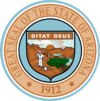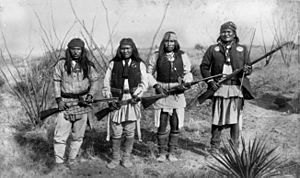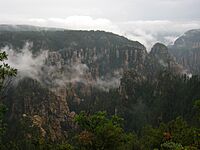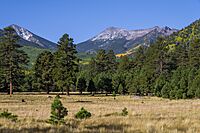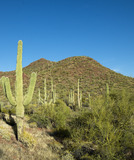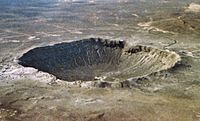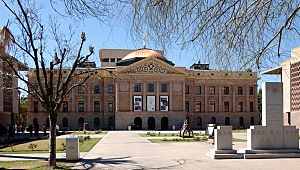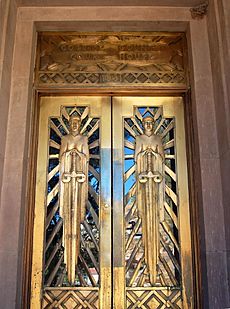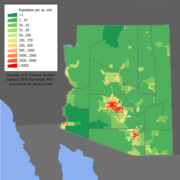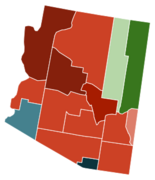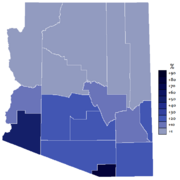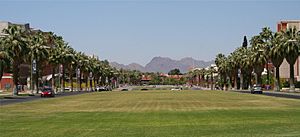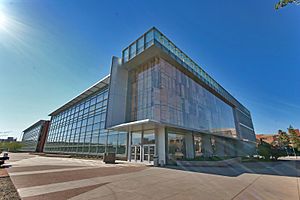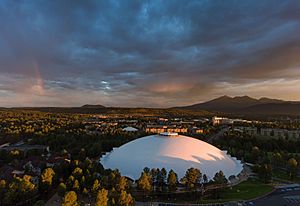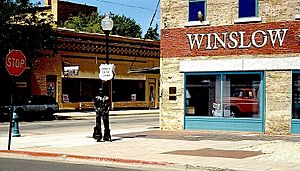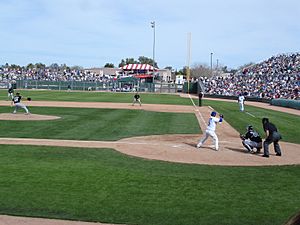Arizona facts for kids
Quick facts for kids
Arizona
|
|||
|---|---|---|---|
|
|||
| Nicknames: | |||
| Motto(s):
Ditat Deus ('God enriches')
|
|||
| Anthem: "The Arizona March Song" and "Arizona" | |||
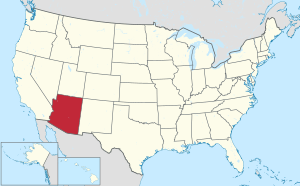
Location of Arizona within the United States
|
|||
| Country | United States | ||
| Before statehood | Arizona Territory | ||
| Admitted to the Union | February 14, 1912 (48th) | ||
| Capital (and largest city) |
Phoenix | ||
| Largest county or equivalent | Maricopa | ||
| Largest metro and urban areas | Phoenix | ||
| Legislature | Arizona State Legislature | ||
| • Upper house | Senate | ||
| • Lower house | House of Representatives | ||
| Judiciary | Arizona Supreme Court | ||
| U.S. senators | Mark Kelly (D) Ruben Gallego (D) |
||
| U.S. House delegation | 6 Republicans 3 Democrats (list) |
||
| Area | |||
| • Total | 113,998 sq mi (295,254 km2) | ||
| Area rank | 6th | ||
| Dimensions | |||
| • Length | 400 mi (645 km) | ||
| • Width | 310 mi (500 km) | ||
| Elevation | 4,100 ft (1,250 m) | ||
| Highest elevation | 12,637 ft (3,852 m) | ||
| Lowest elevation
(Colorado River at the Mexico border)
|
72 ft (22 m) | ||
| Population
(2024)
|
|||
| • Total | |||
| • Rank | 14th | ||
| • Density | 63/sq mi (24/km2) | ||
| • Density rank | 32nd | ||
| • Median household income | $77,300 (2023) | ||
| • Income rank | 28th | ||
| Demonym(s) | Arizonan | ||
| Language | |||
| • Official language | English | ||
| • Spoken language | As of 2010
|
||
| Time zones | |||
| Most of state | UTC−07:00 (Mountain) | ||
| Navajo Nation | UTC−07:00 (Mountain) | ||
| • Summer (DST) | UTC−06:00 (MDT) | ||
| USPS abbreviation |
AZ
|
||
| ISO 3166 code | US-AZ | ||
| Traditional abbreviation | Ariz. | ||
| Latitude | 31°20′ N to 37° N | ||
| Longitude | 109°03′ W to 114°49′ W | ||
| Bird | Cactus wren |
|---|---|
| Fish | Apache trout |
| Flower | Saguaro cactus blossom |
| Tree | Palo verde |
Arizona (pronounced ARR-ih-ZOH-nuh) is a state in the Southwestern United States. It's known for its amazing natural beauty, especially the Grand Canyon. Arizona is one of the "Four Corners" states, meaning it meets Utah, Colorado, and New Mexico at a single point. It also borders Nevada, California, and the Mexican states of Sonora and Baja California.
Arizona is the 6th largest state by area and the 14th most populated. Its capital and largest city is Phoenix. Arizona became the 48th U.S. state on February 14, 1912, which was Valentine's Day!
The southern part of Arizona has a desert climate, with very hot summers and mild winters. But northern Arizona is different! It has pine forests, mountains, and deep canyons. Summers there are much cooler, and it even snows in winter. You can find ski resorts near Flagstaff and Tucson. Besides the famous Grand Canyon, Arizona has many national parks and forests.
About a quarter of Arizona is made up of Indian reservations. These are home to 27 different Native American tribes, including the Navajo Nation. Many people have moved to Arizona since the 1950s, making its population and economy grow a lot. Big companies like PetSmart have their main offices here. The state also has major universities like the University of Arizona and Arizona State University.
Contents
- What's in a Name? The Meaning of Arizona
- Arizona's Past: A Journey Through Time
- Arizona's Amazing Geography
- Arizona's Climate: Hot Deserts to Snowy Mountains
- How Arizona is Governed
- People of Arizona: Demographics and Culture
- Arizona's Economy: What Makes it Tick?
- Getting Around Arizona: Transportation
- Learning in Arizona: Education
- Arts, Culture, and Sports in Arizona
- Images for kids
- See Also
What's in a Name? The Meaning of Arizona
The name Arizona likely comes from an old Spanish name, Arizonac. This name came from the O'odham language, where alĭ ṣonak means "small spring." Spanish settlers first used this name for an area near a silver mine. The O'odham pronunciation sounded like Arissona to them.
Another idea is that the name comes from a Basque phrase, haritz ona, which means "the good oak." There were many Basque sheep herders in the area long ago.
Some people mistakenly think the name comes from the Spanish words Árida Zona, meaning "Arid Zone" (dry area). But this is not true!
Arizona's Past: A Journey Through Time
For thousands of years, many ancient Native American groups lived in Arizona. Cultures like the Hohokam, Mogollon, and Ancestral Puebloans thrived here. You can still see their old pueblos, cliff homes, and rock paintings today. These sites attract many visitors.
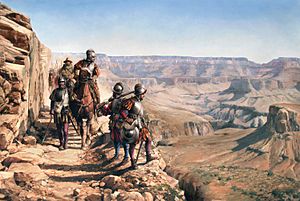
In 1539, a Spanish explorer named Marcos de Niza was the first European to meet Native Americans in this area. Later, in 1540, Coronado explored Arizona while searching for a legendary city. Not many Spanish settlers came to Arizona.
A Jesuit priest named Father Kino started many missions in the late 1600s and early 1700s. He helped convert many Native Americans to Christianity. Spain also built forts in places like Tubac (1752) and Tucson (1775).
When Mexico became independent from Spain in 1821, Arizona became part of Mexico. But after the Mexican–American War (1847–1848), Mexico gave a large part of this land to the United States. This area became part of the territory of New Mexico. In 1853, the U.S. bought the southernmost part of Arizona from Mexico in the Gadsden Purchase. This was to create a good route for a future railway.
During the American Civil War, the southern part of Arizona joined the Confederacy. The U.S. government then created the U.S. Arizona Territory in 1863. This new territory had the same borders as today's state. Prescott became the first capital in 1864 after gold was found. The capital moved a few times before finally settling in Phoenix.
Leaders of the Church of Jesus Christ of Latter-day Saints sent Mormons to Arizona in the mid-to-late 1800s. They founded towns like Mesa and Snowflake.
In the 1800s, people rushed to Arizona for gold and silver. The silver boom in Tombstone, Arizona, in the 1870s, became famous for its outlaws and lawmen. Later, copper mining became very important. By 1907, Arizona produced more copper than any other state, earning it the nickname "the Copper State."
Arizona in the 20th and 21st Centuries
During the Mexican Revolution (1910-1920), some battles happened just across the border from Arizona. In 1918, U.S. and Mexican forces fought in the Battle of Ambos Nogales in Arizona. This was a rare event where fighting from the revolution crossed into the U.S.
Arizona officially became a U.S. state on February 14, 1912. It was the 48th state to join the Union and the last of the states that are connected to each other.

During the Great Depression, cotton farming and copper mining faced hard times. But tourism started to grow. "Dude ranches" and fancy hotels opened, letting visitors experience the "Old West."
During World War II, Arizona had camps for German prisoners of war. It also had camps where Japanese Americans were forced to live. This happened because of fears during the war. Many Japanese Americans lost their homes and businesses. After the war, these camps were closed.
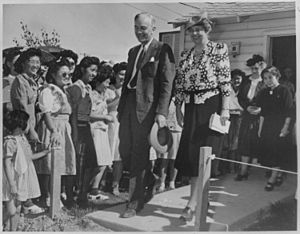
After World War II, Arizona's population grew very quickly. Air conditioning made the hot summers much more comfortable. Many people moved here, including retirees looking for warmer winters. These retirees are often called "snowbirds" because they come for the winter months.
In 2000, Arizona held the first election where people could vote online for a public office. More recently, Arizona has been in the news for its laws about people moving into the state without permission.
Arizona's Amazing Geography
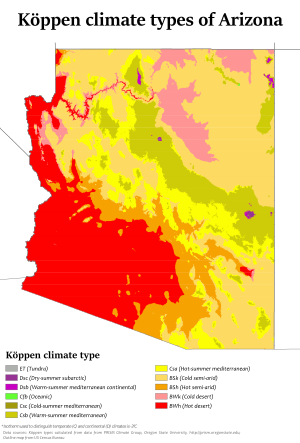
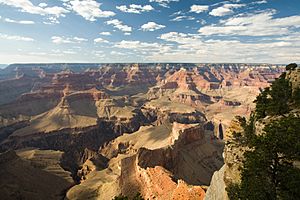
Arizona is in the Southwestern United States. It's the sixth largest state by area. About 15% of the state is privately owned. The rest is public land, like national forests, parks, and Native American reservations. Arizona has 24 sites managed by the National Park Service, including Grand Canyon National Park, Saguaro National Park, and Petrified Forest National Park.
Southern Arizona is famous for its desert landscape, with many cactus plants. This area has very hot summers and mild winters. But northern Arizona is different! It has pine forests and is part of the Colorado Plateau.
Arizona has tall mountains, plateaus, and flat-topped hills called mesas. Even though it's a dry state, 27% of Arizona is covered in forests. It's home to the world's largest group of ponderosa pine trees.
The Mogollon Rim is a huge cliff that cuts across the middle of the state. It marks the edge of the Colorado Plateau.
The Grand Canyon in northern Arizona is a deep, colorful gorge carved by the Colorado River. It's one of the Seven Natural Wonders of the World. The canyon is about 277 miles long and up to 18 miles wide. It's over a mile deep! The river has cut through layers of rock, showing nearly two billion years of Earth's history.
Arizona also has one of the best-preserved meteorite impact sites in the world. Called "Meteor Crater", it was formed about 50,000 years ago. It's a giant hole almost a mile wide and 570 feet deep.
Arizona is one of only two U.S. states that does not use Daylight Saving Time. However, the large Navajo Nation in the northeast part of the state does observe it.
Neighboring States and Countries
- Utah (north)
- Colorado (northeast)
- Nevada (northwest)
- Sonora, Mexico (south)
- Baja California, Mexico (southwest)
- New Mexico (east)
- California (west)
Arizona's Climate: Hot Deserts to Snowy Mountains
Arizona has many different climates because it's a big state with varying elevations.
In the lower desert areas, winters are mild, usually around 40 to 75°F (4 to 24°C). Summers are extremely hot, from 90 to 120°F (32 to 49°C). Temperatures can even go above 125°F (52°C)! The hottest temperature ever recorded in Arizona was 128°F (53°C) in Lake Havasu City. The coldest was -40°F (-40°C) at Hawley Lake.
Arizona gets about 12.7 inches (323 mm) of rain each year. It has two rainy seasons. In winter, cold fronts bring rain from the Pacific Ocean. In summer, there's a "monsoon" season. This brings hot, moist air, leading to thunderstorms, strong winds, and heavy, but usually short, downpours. These can cause dangerous flash floods.
The northern part of Arizona is much higher up and has a cooler climate. Winters are cold, and summers are mild. Temperatures can drop below 0°F (-18°C) in the northern areas.
It's interesting that Arizona has both the city with the most days over 100°F (Phoenix) and the city with the most days below freezing (Flagstaff) in the lower 48 states!
| Location | July (°F) | July (°C) | December (°F) | December (°C) |
|---|---|---|---|---|
| Phoenix | 106/83 | 41/28 | 66/45 | 19/7 |
| Tucson | 100/74 | 38/23 | 65/39 | 18/4 |
| Yuma | 107/82 | 42/28 | 68/46 | 20/8 |
| Flagstaff | 81/51 | 27/11 | 42/17 | 6/−8 |
| Prescott | 89/60 | 32/16 | 51/23 | 11/−5 |
| Kingman | 98/66 | 37/19 | 56/32 | 13/0 |
Major Cities and Towns in Arizona
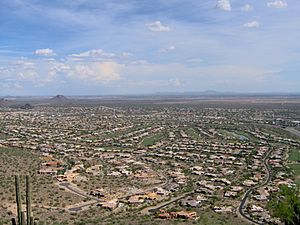
Phoenix is Arizona's capital and largest city. It's in Maricopa County. Many other big cities are part of the Phoenix area, like Mesa, Chandler, and Scottsdale. The whole Phoenix metro area has over 4.7 million people. Phoenix is known for its very hot summers and warm, sunny winters.
Tucson is the state's second-largest city, with over one million people in its metro area. It's about 110 miles southeast of Phoenix. Tucson is home to the University of Arizona. Nearby, Saguaro National Park has the world's largest collection of Saguaro cacti.
The Prescott area is the state's third-largest metro area. Prescott is about 100 miles northwest of Phoenix. It's in pine forests at about 5,500 feet elevation. This means Prescott has much cooler summers and colder winters than Phoenix.
Yuma is in the southwest, near the borders of California and Mexico. It's one of the hottest cities in the U.S., with an average July high of 107°F (42°C). Yuma gets sunny days about 90% of the year. Many visitors come to Yuma in the winter.
Flagstaff is the largest city in northern Arizona. It's almost 7,000 feet high. Flagstaff has large Ponderosa pine forests, snowy winters, and beautiful mountains. It's very different from the desert areas. Flagstaff is near the San Francisco Peaks, which include Humphreys Peak, Arizona's highest point. Many tourists visit Flagstaff because it's close to the Grand Canyon and Sedona. Northern Arizona University is also in Flagstaff.
Lake Havasu City is on the Colorado River and is known as "Arizona's playground." It's famous for its spring break parties and for having the London Bridge, which was moved here from London, England!
|
Largest cities or towns in Arizona
Source: |
||
|---|---|---|
| Rank | Name | Pop. |
| 1 | Phoenix | 1,624,569 |
| 2 | Tucson | 543,242 |
| 3 | Mesa | 509,475 |
| 4 | Chandler | 279,458 |
| 5 | Gilbert | 273,136 |
| 6 | Glendale | 249,630 |
| 7 | Scottsdale | 242,753 |
| 8 | Peoria | 194,917 |
| 9 | Tempe | 184,118 |
| 10 | Surprise | 149,191 |
How Arizona is Governed
Arizona's Capitol Building
The capital of Arizona is Phoenix. The original Capitol building was finished in 1900. It has a special copper dome. Phoenix became the official state capital when Arizona joined the U.S. in 1912.
The buildings for the House of Representatives and Senate were built in 1960. The original Capitol building is now a museum.
The Capitol area also has the Wesley Bolin Memorial Plaza. This plaza has many monuments, including parts of the USS Arizona, a ship sunk at Pearl Harbor.
State Government Branches
Arizona's government has three main parts:
- Legislative Branch: This branch makes the laws. It's called the Arizona Legislature. It has two parts: a 30-member Senate and a 60-member House of Representatives. Each lawmaker is elected for two years. They can serve up to four terms in a row in one part of the Legislature.
- Executive Branch: This branch carries out the laws. It's led by the Governor, who is elected for a four-year term. The governor can serve any number of terms, but only two in a row. Other elected officials include the Secretary of State and the Attorney General.
- Judicial Branch: This branch interprets the laws. The highest court is the Arizona Supreme Court. It has a chief justice and six other justices. They are chosen by the governor from a list of recommended people. There's also the Arizona Court of Appeals and superior courts in each county.
Arizona's Counties
Arizona is divided into 15 counties. They range in size from 1,238 square miles to 18,661 square miles.
| Arizona counties | ||||||
|---|---|---|---|---|---|---|
| County name | County seat | Founded | 2020 population | Percent of total | Area (sq mi) | Percent of total |
| Apache | St. Johns | February 24, 1879 | 66,021 | 0.9% | 11,218 | 9.8% |
| Cochise | Bisbee | February 1, 1881 | 125,447 | 1.8% | 6,219 | 5.5% |
| Coconino | Flagstaff | February 18, 1891 | 145,101 | 2.0% | 18,661 | 16.4% |
| Gila | Globe | February 8, 1881 | 53,272 | 0.7% | 4,796 | 4.2% |
| Graham | Safford | March 10, 1881 | 38,533 | 0.5% | 4,641 | 4.1% |
| Greenlee | Clifton | March 10, 1909 | 9,563 | 0.1% | 1,848 | 1.6% |
| La Paz | Parker | January 1, 1983 | 16,557 | 0.2% | 4,513 | 4.0% |
| Maricopa | Phoenix | February 14, 1871 | 4,420,568 | 61.8% | 9,224 | 8.1% |
| Mohave | Kingman | November 9, 1864 | 213,267 | 3.0% | 13,470 | 11.8% |
| Navajo | Holbrook | March 21, 1895 | 106,717 | 1.5% | 9,959 | 8.7% |
| Pima | Tucson | November 9, 1864 | 1,043,433 | 14.6% | 9,189 | 8.1% |
| Pinal | Florence | February 1, 1875 | 425,264 | 6.0% | 5,374 | 4.7% |
| Santa Cruz | Nogales | March 15, 1899 | 47,669 | 0.7% | 1,238 | 1.1% |
| Yavapai | Prescott | November 9, 1864 | 236,209 | 3.3% | 8,128 | 7.1% |
| Yuma | Yuma | November 9, 1864 | 203,881 | 2.9% | 5,519 | 4.8% |
| Totals: 15 | 7,151,502 | 113,997 | ||||
People of Arizona: Demographics and Culture
| Historical population | |||
|---|---|---|---|
| Census | Pop. | %± | |
| 1860 | 6,482 | — | |
| 1870 | 9,658 | 49.0% | |
| 1880 | 40,440 | 318.7% | |
| 1890 | 88,243 | 118.2% | |
| 1900 | 122,931 | 39.3% | |
| 1910 | 204,354 | 66.2% | |
| 1920 | 334,162 | 63.5% | |
| 1930 | 435,573 | 30.3% | |
| 1940 | 499,261 | 14.6% | |
| 1950 | 749,587 | 50.1% | |
| 1960 | 1,302,161 | 73.7% | |
| 1970 | 1,770,900 | 36.0% | |
| 1980 | 2,718,215 | 53.5% | |
| 1990 | 3,665,228 | 34.8% | |
| 2000 | 5,130,632 | 40.0% | |
| 2010 | 6,392,017 | 24.6% | |
| 2020 | 7,151,502 | 11.9% | |
| 2023 (est.) | 7,431,344 | 16.3% | |
| Sources: 1910–2020 Note that early censuses may not include Native Americans in Arizona 2023 |
|||
In 2020, Arizona's population was about 7.15 million people. This was a 12% increase since 2010! Most of Arizona's people live in the Phoenix and Tucson areas.
Arizona has a diverse population. Many people have moved here from other states and countries. The largest ancestry groups are Mexican, German, English, and Irish.
Languages Spoken in Arizona
As of 2010[update], about 73% of Arizona residents spoke only English at home. Spanish was spoken by 21% of the population. Other languages include Navajo (2%) and German.
Arizona has the most speakers of Native American languages in the connected U.S. states. Over 85,000 people speak Navajo, and over 10,000 speak Apache.
| Language | Percentage of population (as of 2010) |
|---|---|
| Spanish | 21% |
| Navajo | 2% |
| German | <1% |
| Chinese (including Mandarin) | <1% |
| Tagalog | <1% |
| Vietnamese | <1% |
| Other North American indigenous languages (especially indigenous languages of Arizona) | <1% |
| French | <1% |
| Arabic | <1% |
| Apache | <1% |
| Korean | <1% |
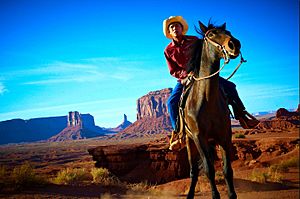
Religion in Arizona
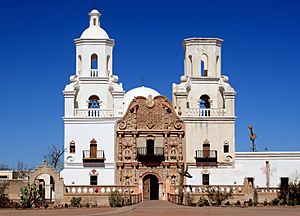
Religious self-identification, per Public Religion Research Institute's 2022 American Values Survey Protestantism (32%) Catholicism (24%) Mormonism (6%) Jehovah's Witness (1%) Unaffiliated (31%) Judaism (2%) New Age (1%) Other (3%)
Many different religions are practiced in Arizona. The largest groups are the Catholic Church, the Church of Jesus Christ of Latter-day Saints, and non-denominational Protestant churches.
Arizona's Economy: What Makes it Tick?
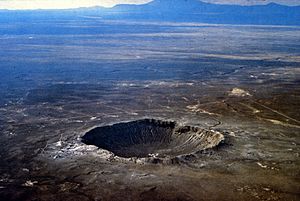
Arizona's economy is quite varied. Important parts include healthcare, transportation, and government.
Historically, Arizona's economy was based on the "five C's":
- Copper: Still a major industry, Arizona produces two-thirds of the nation's copper.
- Cotton
- Cattle
- Citrus
- Climate: This refers to tourism, which is a big part of the economy today.
Many different crops are grown in Arizona, including lettuce, spinach, and watermelon.
Top Employers in Arizona
The state government is Arizona's biggest employer. Banner Health is the largest private employer, with over 39,000 employees. Other large employers include Walmart, Kroger, and Wells Fargo.
Getting Around Arizona: Transportation
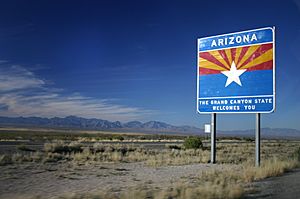
Highways and Roads
Major interstate highways cross Arizona. These include I-17 and I-19 (north-south), and I-8, I-10, and I-40 (east-west). There's also a small part of I-15 in the northwest. Cities like Phoenix have large freeway systems, like the Loop 101.
Public Transport and Trains
Phoenix and Tucson have public bus systems. Greyhound Lines also serves many cities.
Phoenix has a light rail system called Valley Metro Rail. It connects Central Phoenix with Mesa and Tempe. Tucson has the Sun Link streetcar system, which runs through downtown.
Amtrak train services run through Arizona. The Southwest Chief serves northern Arizona, stopping in places like Flagstaff. The Texas Eagle and Sunset Limited serve southern Arizona, stopping in Tucson and Yuma.
Learning in Arizona: Education
Schools for Kids
Public schools in Arizona are run by about 220 local school districts. These districts are overseen by county school superintendents and the Arizona Department of Education.
Colleges and Universities
Arizona has three main public universities:
- University of Arizona (in Tucson)
- Arizona State University (in Tempe/Phoenix area)
- Northern Arizona University (in Flagstaff)
These universities are managed by the Arizona Board of Regents. Arizona also has many private colleges and a large network of two-year community colleges.
Public Universities in Arizona
- Arizona State University, (Sun Devils) Tempe/Phoenix/Mesa/Glendale/Lake Havasu
- Northern Arizona University, (Lumberjacks) Flagstaff/Yuma/Prescott
- University of Arizona, (Wildcats) Tucson/Sierra Vista, MD college in downtown Phoenix and UA Agricultural Center in Yuma/Maricopa
Private Colleges and Universities in Arizona
- American Indian College
- Carrington College
- Arizona Christian University
- Embry-Riddle Aeronautical University
- Grand Canyon University
- Midwestern University
- Northcentral University
- Ottawa University
- University of Phoenix
- Prescott College
- Thunderbird School of Global Management
- University of Advancing Technology
Community Colleges
- Arizona Western College
- Central Arizona College
- Cochise College
- Coconino Community College
- Diné College
- Eastern Arizona College
- Maricopa Community College District:
- Chandler-Gilbert Community College
- Estrella Mountain Community College
- GateWay Community College
- Glendale Community College
- Mesa Community College
- Paradise Valley Community College
- Phoenix College
- Rio Salado College
- Scottsdale Community College
- South Mountain Community College
- Mohave Community College
- Northland Pioneer College
- Pima Community College
- Yavapai College
Arts, Culture, and Sports in Arizona
Art and Museums
The Phoenix Art Museum has a huge collection of art from around the world. The Heard Museum in Phoenix is a major place to see Native American art. It has a Navajo hogan (traditional home) and a collection of Hopi kachina dolls.
Towns like Sedona, Jerome, and Tubac are known for their growing art scenes.
Movies and TV Shows Filmed in Arizona
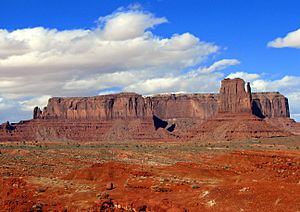
Many Hollywood movies have been filmed in Arizona, especially Westerns. Some famous movies include Raising Arizona and parts of Psycho. The end of the movie Starman takes place at Meteor Crater.
TV shows like Alice and Cops have also been set or filmed in Arizona.
Music from Arizona
Arizona is mentioned in many Country and Western songs, like "By The Time I Get To Phoenix" by Glen Campbell. The famous Eagles song "Take It Easy" also mentions Winslow, Arizona.
Many bands and musicians started in Arizona, including Gin Blossoms, Jimmy Eat World, and The Maine. Famous musicians from Arizona include shock rocker Alice Cooper and Linkin Park's former lead singer, Chester Bennington. Country singers Dierks Bentley and Marty Robbins are also from Arizona.
Sports in Arizona
Arizona is home to several professional sports teams:
| Club | Sport | League | Championships |
|---|---|---|---|
| Arizona Cardinals | American football | National Football League | 2 (1925, 1947) |
| Arizona Diamondbacks | Baseball | Major League Baseball | 1 (2001) |
| Phoenix Suns | Basketball | National Basketball Association | 0 |
| Phoenix Mercury | Basketball | Women's National Basketball Association | 3 (2007, 2009, 2014) |
| Phoenix Rising FC | Soccer | USL Championship | 1 (2023) |
| Tucson Roadrunners | Ice hockey | American Hockey League | 0 |
| Arizona Rattlers | Indoor football | Indoor Football League | 6 (1994, 1997, 2012, 2013, 2014, 2017) |
Arizona has hosted four Super Bowls, including Super Bowl LVII in 2023. Golf is also popular, with the Phoenix Open being a major event. Auto racing is big too, with NASCAR races held at Phoenix Raceway.
College Sports in Arizona
College sports are very popular. The Arizona State Sun Devils and the Arizona Wildcats are big rivals. Their football game is for the Territorial Cup, which is the oldest trophy in college football!
Arizona also hosts several college football bowl games, like the Fiesta Bowl.
Baseball in Arizona
Arizona is a popular place for Major League Baseball teams to do their spring training. This is called the Cactus League. It started in 1947.
The Arizona Diamondbacks baseball team started playing in 1998. They won the 2001 World Series!
Images for kids
-
Children of Depression-era migrant workers, Pinal County, 1937
See Also
 In Spanish: Arizona para niños
In Spanish: Arizona para niños



